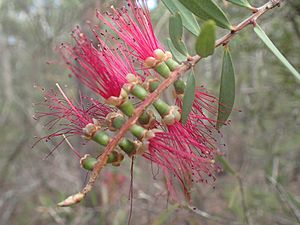Megalong Valley bottlebrush facts for kids
Quick facts for kids Megalong Valley bottlebrush |
|
|---|---|
 |
|
| Melaleuca megalongensis flowers | |
| Conservation status | |
| Scientific classification | |
| Genus: |
Melaleuca
|
| Species: |
megalongensis
|
| Synonyms | |
|
Callistemon megalongensis (Craven & S.M.Douglas) Udovicic & R.D.Spencer |
|
The Megalong Valley bottlebrush (scientific name: Melaleuca megalongensis) is a special plant found only in New South Wales, Australia. It belongs to the Myrtaceae family, which includes many well-known Australian plants like eucalyptus. This plant looks a lot like another bottlebrush called the common red bottlebrush (Melaleuca citrina). It can be tricky to tell them apart unless they are flowering!
Contents
What Does the Megalong Valley Bottlebrush Look Like?
The Megalong Valley bottlebrush is a shrub that can grow up to about 5 meters (16 feet) tall. It has soft bark that often peels off. Its leaves are arranged one after another along the stem. They are about 35 to 55 millimeters (1.4 to 2.2 inches) long and 3.5 to 5 millimeters (0.14 to 0.2 inches) wide. The leaves are flat and shaped like a narrow egg, with the narrower end at the base. They have a main vein in the middle and many smaller veins (15 to 24) branching out.
Flowers and Fruit
The flowers of the Megalong Valley bottlebrush grow in spikes at the ends of branches. These spikes are about 30 to 40 millimeters (1.2 to 1.6 inches) across and have 25 to 60 individual flowers. Each flower has petals that are about 3.0 to 3.7 millimeters (0.12 to 0.15 inches) long. These petals fall off as the flower gets older.
Each flower also has 45 to 50 stamens. Stamens are the parts of the flower that produce pollen. The stamens on this plant are pink, and the pollen-producing tips (called anthers) are dark red. This plant usually flowers in November and December. After flowering, it produces woody fruits that look like small capsules, about 6 millimeters (0.24 inches) long.
How Was It Named?
The Megalong Valley bottlebrush was officially described in 2009 by a scientist named Lyndley Craven. Its scientific name, megalongensis, tells us where this plant is found. It refers to the Megalong Valley where it grows.
Sometimes, you might see this plant called Callistemon megalongensis. This is considered a synonym, which means it's another name for the same plant.
Where Does It Live?
This special bottlebrush only lives in the Megalong Valley in the Blue Mountains area of New South Wales. It likes to grow in wet places, especially near streams.
Why Is It Important to Protect It?
The Megalong Valley bottlebrush is classified as "critically endangered." This means there are very few of these plants left in the wild, and they are at a very high risk of disappearing forever. Both the Australian Government and the NSW Government have recognized its endangered status. Protecting this plant helps keep our natural world diverse and healthy.
Images for kids




